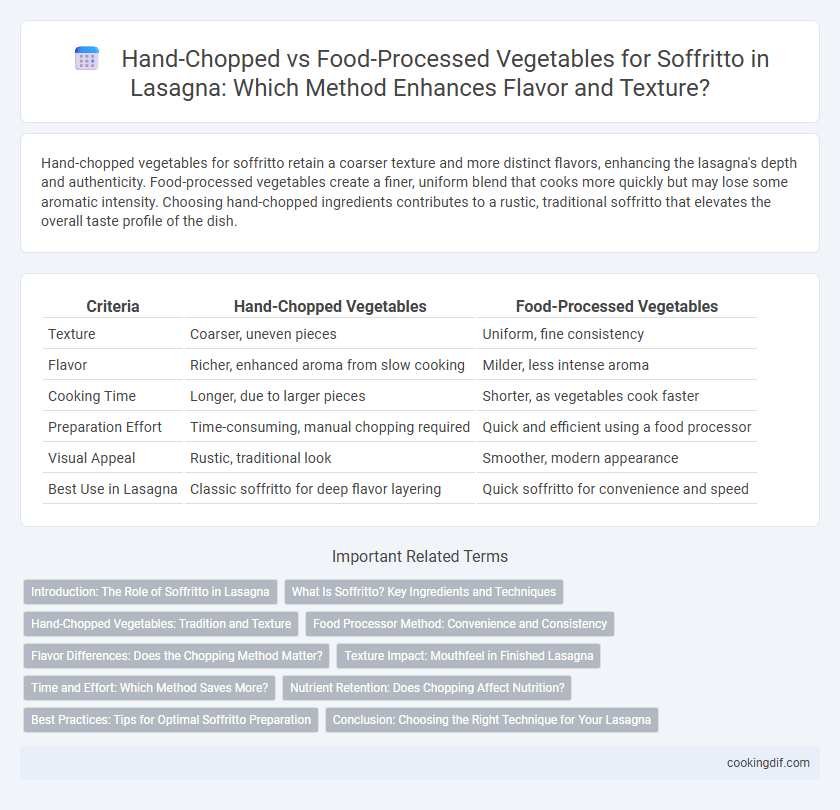Hand-chopped vegetables for soffritto retain a coarser texture and more distinct flavors, enhancing the lasagna's depth and authenticity. Food-processed vegetables create a finer, uniform blend that cooks more quickly but may lose some aromatic intensity. Choosing hand-chopped ingredients contributes to a rustic, traditional soffritto that elevates the overall taste profile of the dish.
Table of Comparison
| Criteria | Hand-Chopped Vegetables | Food-Processed Vegetables |
|---|---|---|
| Texture | Coarser, uneven pieces | Uniform, fine consistency |
| Flavor | Richer, enhanced aroma from slow cooking | Milder, less intense aroma |
| Cooking Time | Longer, due to larger pieces | Shorter, as vegetables cook faster |
| Preparation Effort | Time-consuming, manual chopping required | Quick and efficient using a food processor |
| Visual Appeal | Rustic, traditional look | Smoother, modern appearance |
| Best Use in Lasagna | Classic soffritto for deep flavor layering | Quick soffritto for convenience and speed |
Introduction: The Role of Soffritto in Lasagna
Soffritto is a fundamental component in lasagna, providing a rich flavor base typically made from onions, carrots, and celery. Hand-chopped vegetables release textures and aromas differently than food-processed ones, influencing the soffritto's depth and mouthfeel. This meticulous preparation ensures a robust and authentic taste that elevates the overall lasagna experience.
What Is Soffritto? Key Ingredients and Techniques
Soffritto is a foundational Italian mixture of finely chopped vegetables, primarily onions, carrots, and celery, used to build flavor in dishes like lasagna. Hand-chopping soffritto ingredients offers greater texture control and prevents over-processing, preserving the distinct vegetable flavors crucial for authentic taste. Food processing, while faster, can create a uniform puree that may dull the aromatic complexity essential for traditional soffritto-based sauces.
Hand-Chopped Vegetables: Tradition and Texture
Hand-chopped vegetables for soffritto preserve the traditional texture and release flavors gradually, enhancing the depth of lasagna sauce. Each piece varies in size, allowing a rustic, artisanal quality that food processors often cannot replicate. This method maintains a balance of softness and bite, crucial for authentic Italian lasagna layers and rich flavor complexity.
Food Processor Method: Convenience and Consistency
Using a food processor for chopping vegetables in soffritto offers unmatched convenience and consistency, ensuring evenly sized pieces that cook uniformly. This method significantly reduces preparation time, allowing for quicker meal assembly without compromising texture or flavor. The precise and uniform cuts achieved by food processors enhance the overall quality and presentation of the lasagna.
Flavor Differences: Does the Chopping Method Matter?
Hand-chopped vegetables for soffritto release distinct, vibrant flavors due to uneven cuts that retain texture and essential oils, enhancing lasagna's depth. Food-processed vegetables create a uniform texture but may result in a milder, less aromatic soffritto, potentially flattening the overall flavor profile. The chopping method significantly influences the intensity and complexity of flavors, making hand-chopping preferable for authentic lasagna.
Texture Impact: Mouthfeel in Finished Lasagna
Hand-chopped vegetables for soffritto retain a coarser, uneven texture that creates a more rustic mouthfeel in finished lasagna, enhancing bite contrast and sensory interest. Food-processed vegetables produce a finer, uniform texture that integrates seamlessly into the sauce, resulting in a smoother, more cohesive layering experience. The choice between hand-chopping and food-processing directly influences the lasagna's textural complexity and overall eating satisfaction.
Time and Effort: Which Method Saves More?
Hand-chopping vegetables for soffritto demands significantly more time and effort, often taking 10-15 minutes to finely dice onions, carrots, and celery. Food processing reduces preparation time to 2-3 minutes, providing a consistent texture with minimal physical strain. For busy cooks aiming to save time without compromising flavor integration, food-processed soffritto is the more efficient choice.
Nutrient Retention: Does Chopping Affect Nutrition?
Hand-chopping vegetables for soffritto preserves more nutrients compared to food processing, as the slower cutting motion reduces cell damage and limits oxidation. Food processors tend to generate heat and cause rapid cell disruption, leading to greater nutrient loss, particularly of sensitive vitamins like vitamin C and folate. Choosing hand-chopped soffritto enhances nutrient retention and contributes to a richer flavor profile in lasagna.
Best Practices: Tips for Optimal Soffritto Preparation
Hand-chopping vegetables for soffritto enhances texture and releases natural flavors more gradually, creating a richer base for lasagna sauce. Using a food processor speeds up preparation but can result in uneven cuts and a slightly bitter taste due to cell damage and oxidation. For optimal soffritto, finely dice vegetables by hand or pulse in the food processor carefully to maintain consistent size and preserve the aromatic qualities essential to authentic lasagna.
Conclusion: Choosing the Right Technique for Your Lasagna
Hand-chopping vegetables for soffritto offers a coarser texture and enhanced flavor release, ideal for traditional, rustic lasagna recipes. Food-processing vegetables provides uniformity and speed, perfect for busy cooks seeking consistency in their sauce base. Selecting the right method depends on your desired texture and time constraints, with hand-chopped soffritto elevating depth while food-processed ensures efficiency.
Hand-chopped vs Food-processed vegetables for soffritto Infographic

 cookingdif.com
cookingdif.com